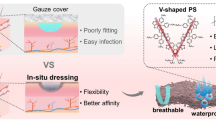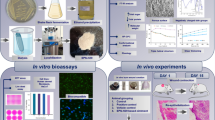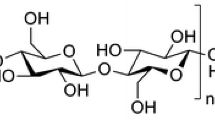Abstract
The purpose of this study was to investigate the effect of sodium carboxymethylcellulose (Na-CMC) and fucidic acid on the gel characterization for the development of sodium fucidate-loaded wound dressing. The cross-linked hydrogel films were prepared with polyvinyl alcohol (PVA) and sodium carboxymethylcellulose (Na-CMC) using the freeze-thawing method. Their gel properties such as gel fraction, swelling, water vapor transmission test, morphology, tensile strength and thermal property were investigated. In vitro protein adsorption test and release were performed. Na-CMC decreased the gel fraction and tensile strength of the hydrogels, but increased the swelling ability, water vapor transmission rate, elasticity and porosity of hydrogels. Thus, the wound dressing developed with PVA and Na-CMC was more swellable, flexible and elastic than that with only PVA because of its cross-linking interaction with PVA. However, the drug had a negative effect on the gel properties of hydrogels but there were no significant differences. In particular, the hydrogel composed of 2.5% PVA, 1.125% Na-CMC and 0.2% drug might give an adequate level of moisture and build up the exudates on the wound area. Thus, this sodium fucidate-loaded hydrogel could be a potential candidate for wound dressing with excellent forming.
Similar content being viewed by others
References
Abou, T. M. F., El-Mohdy, H. L. A., and El-Rehim, H. A. A., Radiation preparation of PVA/CMC copolymers and their application in removal of dyes. J. Hazard. Mater., 168, 68–75 (2009).
Adekogbe, I. and Ghanem. A., Fabrication and characterization of DTBP-cross-linked Na-CMC scaffolds for skin tissue engineering. Biomaterials, 26, 7241–7250 (2005).
Ajji, Z., Othman, I., and Rosiak J. M., Production of hydrogel wound dressing using gamma radiation. Nucl. Instrum. Methods Phys. Res. B, 229, 375–380 (2005).
Ajji, Z., Mirjalili, G., Alkhatab, A., and Dada, H., Use of electron beam for the production of hydrogel dressings. Radiat. Phys. Chem., 77, 200–202 (2008).
Bae, J. S., Jang, K. H., Park, S. C., and Jin, H. K., Promotion of dermal wound healing by polysaccharides isolated from Phellinus gilvus in rats. J. Vet. Med. Sci., 67, 111–114 (2005).
Balakrishnan, B., Mohanty, M., Umashankar, P. R., and Jayakrishnan, A., Evaluation of an in situ forming hydrogel wound dressing based on oxidised alginate and gelatin. Biomaterials, 26, 6335–6342 (2005).
Biswal, D. R. and Singh, R. P., Characterization of carboxymethyl cellulose and polyacrylamide graft copolymer. Carbohydr. Polym., 57, 379–387 (2004).
Cascone, M. G., Sim, B., and Downes, S., Blends of synthetic and natural polymers as drug delivery systems for growth hormone. Biomaterials, 16, 569–574 (1995).
Choi, Y. S., Hong, S. R., Lee, Y. M., Song, K. W., Park, M. H., and Nam, Y. S., Study on gelatin-containing artificial skin: I Preparation and characteristics of novel gelatin-alginate sponge. Biomaterials, 20, 409–417 (1999).
Dion, I., Baquey, C., Havlik, P., and Monties, J. R., A new model to test platelet adhesion under dynamic conditions Application to the evaluation of a titanium nitride coating. Int. J. Artif. Organs., 16, 545–550 (1993).
Gaisford, S., Beezer, A. E., Bishop, A. H., Walker, M., and Parsons, D., An in vitro method for the quantitative determination of the antimicrobial efficacy of silver-containing wound dressings. Int. J. Pharm., 366, 111–116 (2009).
Gehrig, K. A. and Warshaw, E. M., Allergic contact dermatitis to topical antibiotics: Epidemiology, responsible allergens, and management. J. Am. Acad. Dermatol., 58, 1–21 (2008).
Hassan, C. M., Stewart, J. E., and Peppas, N. A., Diffusional characteristics of freeze/thawed poly (vinyl alcohol) hydrogels: Applications to protein controlled release from multilaminate devices. Eur. J. Pharm. Biopharm., 49, 161–165 (2000).
Hinnman, C. D. and Maibach. H., Effect of air exposure and occlusion on experimental human skin wounds. Nature, 200, 377–378 (1963).
Hirose, K., Onishi, H., Sasatsu, M., Takeshita, K., Kouzuma, K., Isowa, K., and Machida, Y., In vivo evaluation of Kumazasa extract and Na-CMC films containing the extract against deep skin ulcer model in rats. Biol. Pharm. Bull., 30, 2406–2411 (2007).
Hoffman, A. S., Hydrogels for biomedical applications. Adv. Drug Deliv. Rev., 54, 3–12 (2002).
Huang, M. H. and Yang, M. C., Evaluation of glucan/poly (vinyl alcohol) blend wound dressing using rat models. Int. J. Pharm., 346, 38–46 (2008).
Kim, I. Y., Yoo, M. K., Kim, B. C., Kim. S. K., Lee, H. C., and Cho, C. S., Preparation of semi-interpenetrating polymer networks composed of Na-CMC and poloxamer. Int. J. Biol. Macromol., 38, 51–58 (2006).
Kim, J. O., Park, J. K., Kim, J. H., Jin, S. G., Yong, C. S., Li, D. X., Choi, J. Y., Woo, J. S., Yoo, B. K., Lyoo, W. S., Kim, J. A., and Choi, H. G., Development of polyvinyl alcohol-sodium alginate gel-matrix-based wound dressing system containing nitrofurazone. Int. J. Pharm., 359, 79–86 (2008a).
Kim, J. O., Choi, J. Y., Park, J. K., Kim, J. H., Jin, S. G., Chang, S. W., Li, D. X., Hwang, M. R., Woo, J. S., Kim, J. A., Lyoo, W. S., Yong, C. S., and Choi, H. G., Development of clindamycin-loaded wound dressing with polyvinyl alcohol and sodium alginate. Biol. Pharm. Bull., 31, 2277–2282 (2008b).
Kokabi, M., Sirousazar, M., and Hassan, Z. M., PVA-clay nanocomposite hydrogels for wound dressing. Eur. Polym. J., 43, 773–781 (2007).
Li, X., Wu, W., and Liu, W., Synthesis and properties of thermo-responsive guar gum/poly(N-isopropylacrylamide) interpenetrating polymer network hydrogels. Carbohydr. Polym., 71, 394–402 (2008).
Lin, W. C., Yu, D. G., and Yang, M. C., Blood compatibility of novel PGA (poly glutamic acid)/poly vinyl alcohol hydrogels. Colloids Surf. B Biointerfaces, 47, 43–49 (2006).
Morin, R. J. and Tomaselli, N. L., Interactive dressings and topical agents. Clin. Plast. Surg., 34, 643–658 (2007).
Pakrooh, H., Comparative trial of fucidin ointment and fucidin cream in skin sepsis. J. Int. Med. Res., 8, 425–429 (1980).
Peppas, N. A., Turbidimetric studies of aqueous poly (vinyl alcohol) solutions. Makromol. Chem., 176, 3433–3440 (1975).
Peppas, N. A., Analysis of fickian and non-fickian drug release polymers. Pharm. Acta Helv., 60, 110–111 (1985).
Perioli, L., Ambrogi, V., Venezia, L., Giovagnoli, S., Pagano, C., and Rossi, C., Formulation studies of benzydamine mucoadhesive formulations for vaginal administration. Drug Dev. Ind. Pharm., 35, 769–779 (2009).
Queen, D., Gaylor, J. D. S., Evans, J. H., Courtney, J. M., and Reid, W. H., The preclinical evaluation of the water vapor transmission rate through burn wound dressings. Biomaterials, 8, 367–371 (1987).
Razzak. M. T., Darmawan. D., and Zainuddin. S., Irradiation of polyvinyl alcohol and polyvinyl pyrrolidone blended hydrogel for wound dressing. Radiat. Phys. Chem., 62, 107–113 (2001).
Rosiak, M. T., Darmawan, D., and Zainuddin, S., Irradiation of polyvinyl alcohol and polyvinyl pyrrolidone blended hydrogel for wound dressing. Radiat. Phys. Chem., 62, 107–113 (2001).
Stashak, T. S., Farstvedt, E., and Othic, A., Update on wound dressings: Indications and best use. Clin. Tec. Eq. Prac., 3, 148–163 (2004).
Stauffer, S. R. and Peppas, N. A., Poly (vinyl alcohol) hydrogels prepared by freezing-thawing cyclic processing. Polymer., 33, 3932–3936 (1992).
Tabbara, K. F., Antonios, S., and Alvarez, H., Effects of fucidic acid on staphylococcal keratitis. Br. J. Ophthalmol., 73, 136–139 (1989).
Tang, Y. F., Du, Y. M., Hu, X. W., Shi, X. W., and Kennedy, J. F., Rheological characterisation of a novel thermosensitive chitosan/poly(vinyl alcohol) blend hydrogel. Carbohydr. Polym., 67, 491–499 (2007).
Turner, T. D., Hospital usage of absorbent dressings. Pharm. J., 222, 421–424 (1979).
Valenta, C. and Auner, B. G., The use of polymers for dermal and transdermal delivery. Eur. J. Pharm. Biopharm., 58, 279–289 (2004).
Winter, G. D., Formation of the scab and the rate of epithelization of superficial wounds in the skin of the young domestic pig. Nature, 193, 293–294 (1962).
Yang, J. M., Su, W. Y., Leu. T. L., and Yang. M. C., Evaluation of Chitosan/PVA blended hydrogel membranes. J. Memb. Sci., 236, 39–51 (2004).
Yang, X., Liu, Q., Chen, X., Yu, F., and Zhu, Z., Investigation of PVA/Chitosan hydrogels prepared by combined γ-irradiation and freeze-thawing. Carbohydr. Polym., 73, 401–408 (2008).
Yeo, J. H., Lee, K. G., Kim, H. C., Oh, Y. L., Kim, A. J., and Kim, S. Y., The effects of PVA/Na-CMC/fibroin (PCF)-blended spongy sheets on wound healing in rats. Biol. Pharm. Bull., 23, 1220–1223 (2000).
Yokoyama, F., Masada, I., Shimamura, K., Ikawa, T., and Monobe. K., Morphology and structure of highly elastic poly(vinyl alcohol) hydrogel prepared by repeated freezing-and-melting. Colloid Polym. Sci., 264, 595–601 (1986).
Yoo, M. K., Kweon, H. Y., Lee, K. G., Lee, H. C., and Cho, C. S., Preparation of semi-interpenetrating polymer networks composed of silk fibroin and poloxamer macromer. Int. J. Biol. Macromol., 34, 263–270 (2004).
Author information
Authors and Affiliations
Corresponding authors
Rights and permissions
About this article
Cite this article
Lim, SJ., Lee, J.H., Piao, M.G. et al. Effect of sodium carboxymethylcellulose and fucidic acid on the gel characterization of polyvinylalcohol-based wound dressing. Arch. Pharm. Res. 33, 1073–1081 (2010). https://doi.org/10.1007/s12272-010-0714-3
Received:
Revised:
Accepted:
Published:
Issue Date:
DOI: https://doi.org/10.1007/s12272-010-0714-3




